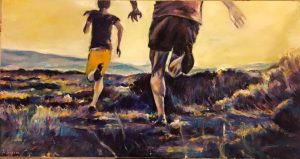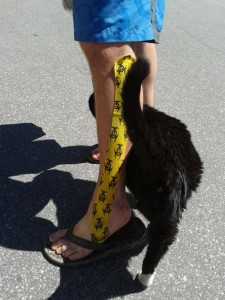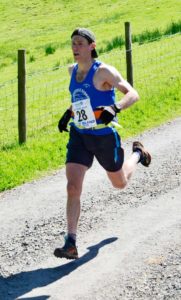As mentioned in a previous blog – and indeed in our last newsletter (sign up here if you didn’t get it), we really are into spring marathon training time now. 10ks and half marathons have been run as build up races, training distances will be getting longer, and time on feet will be increasing as the big day beckons.
From about mid-February onwards we get calls from runners from all distances – from those just starting out on parkruns to experienced and dedicated racers, and to cut a long story short, the basic content of these calls boils down to “My God! My calves!”.
Calf muscles are some of the main propulsive drivers of running, yes they also get used in walking and standing etc, but when you switch from walking to running a significantly different type of force gets put through them. Instead of simply being used to transfer bodyweight from foot to foot during walking, the muscles and tendons become used as energy storage and return mechanisms. This is the bit of your leg that literally puts the spring into your step.
Of course other muscles get used in different ways as you progress with running, but none seem to be more temperamental than the ones at the bottom of your legs. Calf pain when running – and also soreness after running – puts a considerable downer on the general experience and can be such a turn off that people stop running altogether.
It doesn’t help when the main bit of advice generally given out is to stretch – and to self massage or foam roller the offending muscle. Yes, this can help, but need to be done in moderation. A painful calf just begs to be stretched and rollered and stretched again, and maybe pummelled by someone else before heading out on another run… where almost inevitably, it will “tighten up” again. Foam rollers and massage, and even rest on its own are not magic wands which will disappear the pain away. What else can you possibly do?!
Time for a little reminiscence, if you will indulge me…. In Early September 2015 I was coming off the back of some good fell races. It was actually my most prolific fellrunning season to date (ever, in fact), and I was feeling good. The Eryri marathon was coming up in late October so I decided to get a few road miles in, just for a bit of preparation. I could easily do the distance off-road, but wanted to be in good shape on road as well. My first road training run did not go well. It was 10k and ended up getting the strava title “A lesson in pain and pacing. But mostly pain”. My calves were in agony within about 3k, I battled through and by the end I could barely walk. The next few days were, shall we say, not entirely fun.

Fixing calves? Tape? Cats? Sunshine?
But, the calf pain settled down. Over the next few weeks I did the same thing, but longer each time – letting the calves recover in between times.
Now, I had the luxury of aerobic fitness from the year of racing and it was only the calf issue that I had to contend with. My main problem was that I was running on an entirely different type of terrain (and indeed speed) than I was used to, hence the ridiculous pain in my calves.
It might seem innocuous, but going from 20k off road to 7k on road might be enough to make your calves go “oooh” and stop you from running.
Fear not, however. Generally, the pain is temporary. It tends to be DOMS – Delayed Onset Muscle Soreness (sometimes, not so delayed…). The pain does not necessarily mean your calves are going to explode, it simply means you have over-extended yourself somewhat, either in terms of distance or pace, or have changed something else (shoes/surface etc). If you prod the calf, yes, it will hurt. But if you did that 3 weeks ago it would have hurt then as well. Feel free to massage it a bit, roll it a bit, but you really don’t need to go to town on it. The muscle is already trying to heal, so give it a hand, don’t batter it into submission. It will not thank you.
Stretch a little, that is fine, but don’t think that stretching will make the feeling go away.
What your muscles need to do is recover before you go and hammer them again. Simple rest on its own won’t do that. Walk, cycle, do a little bit of walk/running (with much more walking than running), be SENSIBLE. Better to miss out on some of your training runs than to miss out on the actual marathon day.
Strengthen the muscles – calf raises are a good idea – but the idea is to do few – and do them heavy.
Perhaps the best thing to do is not have the issue in the first place. If you aren’t running on the surface the marathon is on (most likely road), and you are training on a trail, slowly introduce small amounts of tarmac and pavement to your runs in order to inoculate yourself against the impact. Vary your routes – don’t always run them the same way, run the loop in the opposite direction if necessary. Variation is good, but introduce the variety slowly and steadily.

Let’s pretend this is me finishing the marathon. (I can’t find the actual picture- and this one was taken within about 2km of where the race finished anyway…. and its not on grass….)
Of course, as ever, this is a blog, it is not science based, I do not have studies to back everything here up, only the experience of n=1. (me). If you have calf pain that is worrying you, symptoms that are of a prolonged duration, swollen legs or anything like that, see a professional. Tired muscles, compartment syndrome, DVT, these are all things that may or may not be occurring. There are some things that you do not want to mess with and its best to get them checked out sooner rather than later. I’ve only once seen someone with DVT and they got sent straight to A&E.
Oh, and the marathon went fine in the end. 2:58. I can’t remember if my calves hurt. They probably did.




